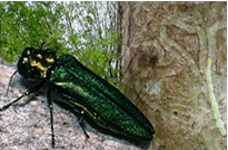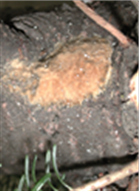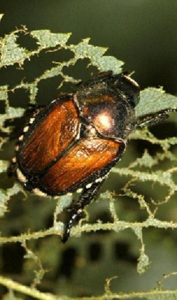By Dale Anderson, Plant Quarantine and Pest Survey Specialist, SD Department of Agriculture, and provided by him to SDCOA
The South Dakota Department of Agriculture (SDDA) and the United States Department of Agriculture, Animal and Plant Health Inspection Service, Plant Protection and Quarantine (PPQ) continue to work cooperatively on plant pest protection issues, relying extensively on the cooperation of private businesses including the campground owners. Thank you for your cooperation.

Emerald Ash Borer:
The EAB continues to exist in eastern South Dakota, but to our knowledge did not expand its range in the state this year. It is still only confirmed in the Sioux Falls area. Many communities and landowners in South Dakota have begun the pre-emptive removal of their ash resource. For now, the state quarantine in Minnehaha, northeastern Turner and northern Lincoln Counties will continue in 2020 without changes.
Previously, the USDA-APHIS-PPQ oversaw the detection trapping for EAB in South Dakota. In 2019, they stopped all EAB detection activity, with the exception that they supplied traps and lures to states willing to conduct detection work. The SDDA did conduct some trapping at several key locations with trapping supplies provided by USDA. Others that assisted with the trapping included SDSU Extension, city parks departments, and others. In all, about 65 traps were deployed. According to received reports, no additional EAB infested locations were discovered by this trapping. However, informed visual observation remains the best tool for early detection of this insect. The primary clues are thinning canopy, heavy woodpecker damage, and D shaped exit holes.
We took a fair number of calls concerning the state EAB quarantine. One item is that our quarantine mirrors the quarantine rules of the USDA and in other states. However, the City of Sioux Falls took an additional step. They implemented additional rules restricting ash tree removal and/or trimming during the summer months, except for hazard situations of course. This rule is designed to reduce the spread within the quarantine area. It’s the law in Sioux Falls, and a good best management practice for everyone else that might have unknown infestations of this insect.
Nationwide, EAB continued to be found in new areas in 2019. Currently, EAB has been found in approximately 35 states. Of particular concern to South Dakotans, EAB was found in three additional counties in Minnesota, one additional county near Omaha, although Nebraska increased their quarantine by three counties, four additional counties in Iowa, and one additional county in Colorado in 2019.
In the fall of 2018, PPQ issued a proposal to remove the federal quarantine regulations on EAB. For a recap on this proposal, please refer to this newsletter submission last year. Due to time constraints caused by the government shutdown last winter, and a large number of responses during the public comment period, the USDA did not act on this proposal in 2019. We expect a decision to be announced within the next several months.
The USDA continues to fund the EAB bio-control program, and releases of several bio-control agents which feed on EAB were released in Sioux Falls in 2018 and 2019. Additional releases, as well as tests for establishment, are planned in 2020.
If you’re interested in additional information about EAB, please review this web page: https://www.aphis.usda.gov/aphis/ourfocus/planthealth/plant-pest-and-disease-programs/pests-and-diseases/emerald-ash-borer/emerald-ash-borer, or for South Dakota specific information: http://emeraldashborerinsouthdakota.sd.gov/

Gypsy Moth:
Gypsy moth detection is conducted by the SDDA, the PPQ office in Pierre, as well as many cooperating individuals throughout the state. The locations that were detected as positive in 2018 were negative this year. However, we did capture 3 moths; one each at two campgrounds in Pennington County, and one in Minnehaha County. We currently believe there are no established populations of gypsy moth in South Dakota, and plan to continue with follow-up trapping next year at these locations.
Japanese Beetle:
The Japanese beetle has continued to cause concern in 2019. A detection survey was conducted by SDDA and cooperators using traps at 131 locations in 34 counties. Cooperators included Pennington County Weed & Pest and SD Master Gardeners placed additional traps. In general, Japanese beetles were detected in the usual areas, although the trapped numbers were lower in most locations this year. The exception is Madison, where a significant increase from last year was detected. We are working with City of Madison staff to develop a treatment plan to help contain and reduce the amount of JB in those areas.

Currently, we consider Japanese beetle established in Brookings, Brown, Clay, Codington, Lake, northern Lincoln, Minnehaha, Pennington, and Union counties. This year, detections of low numbers of beetles were found in Butte, Custer, Fall River, and Davison Counties. Several counties where low numbers were detection last year were negative this year. We’ll continue detection trapping in 2020, as well as going after small populations so long we feel we can have an impact on the potential population.
